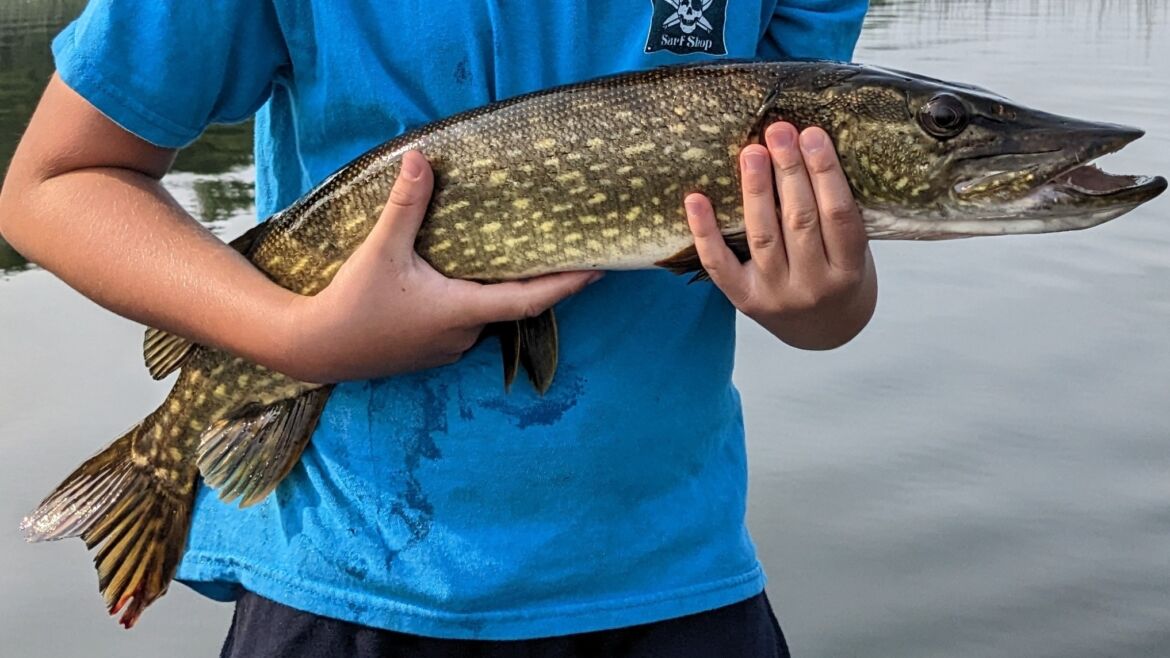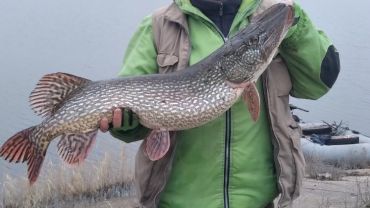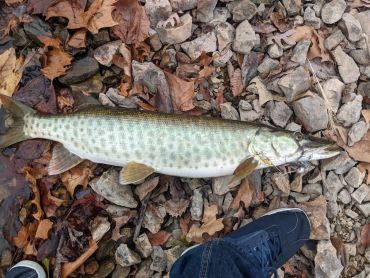Northern Pike, or the freshwater shark as many experienced anglers call them, are a once-in-a-lifetime freshwater fish that every angler should catch at least once. Be warned, though, these clever, wily, and large fish not only put up a considerable fight when you do manage to hook one but chasing Northern Pike can quickly become addictive!
With a large mouth and rows of razor-sharp teeth, catching a big Northern Pike will never be easy. However, thanks to their voracious appetite, if you’re fishing in waters that Northern Pike frequent, you’ve got a good chance of hooking into one of these freshwater monsters.
Northern Pike can grow much larger than regular freshwater fish. In fact, the record United States Northern Pike weighed in at 46 lbs. and was caught by angler Peter Dubuc in 1940. There are some reports of larger Northern Pike, but some were misidentified, or there wasn’t enough proof.
The experience of hooking, fighting, and landing a Northern Pike can be an emotional rollercoaster ride of adrenaline the first time it happens, but it’s a once-in-a-lifetime experience that all anglers should have the opportunity to experience at least once in their lifetime.
In the following guide to catching Northern Pike, we’ll cover:
If you love freshwater fishing, be sure to check out Maximize Your Catch: Guide to the Best Freshwater Fishing Baits! This is our complete guide to understanding and using the best freshwater baits to maximize your catch rate and improve your time on the water.
When it comes to catching big Northern Pike, even the most experienced anglers will need a little help, especially if they’ve just started chasing these monster freshwater fish or you plan on fishing in a new area. Thanks to the Fishbox App, a premium app for fishing, you’ll have access to the advanced technology used by the Fishbox App, including the best time to go fishing and when you’re better off relaxing at home and getting your fishing tackle or boat ready for your next freshwater adventure.
Get your personalized fishing map
Answer a quick quiz and get your own personalized fishing map
Expert Opinion on How to Catch Northern Pike
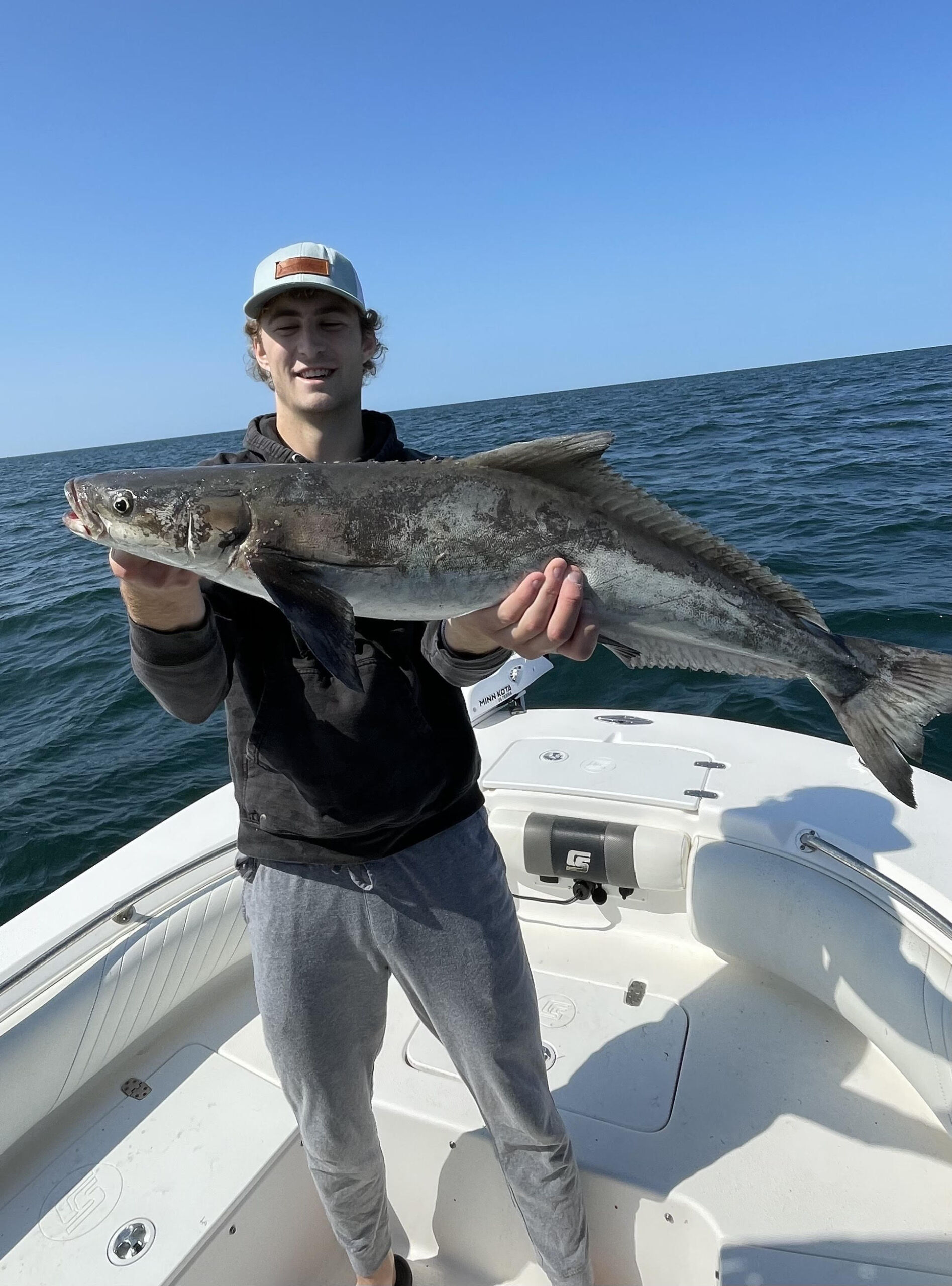
Pierce Latta
16 years fishing experience
“While I have never caught a northern pike myself, I have done a lot of reading and research about the species and do plan on targeting them in the future. Additionally, reading this article has greatly increased my knowledge of the subject.
The article kicks off with a section about understanding the nature of pike. We get a little information about the size of the pike as the article discusses record and average sizes.
We immediately go straight into a section about the gear needed to wrangle one of these fish. Prior to reading this article, I really had no clue what gear was required to fish for a pike. Fortunately, this article has me covered. I also loved how this section goes further than just rod, reel, and line. Too often, I feel like we focus too much on what is in our hands—which is good—but we also need to focus on what needs to be on the shore or in the boat right next to us. Some of the extra tackles mentioned are landing nets and pliers.
Shortly thereafter, the article goes into a section talking about the best baits for pike. Once again, I don’t really know too much about what pike eat in the wild, so this section was also super helpful. One thing that the article touches on is how pike eats a ton of different things, including live, dead, and artificial baits. This was encouraging to me because there’s not one straightforward path to take to catch these fish. Not only does this make catching the fish more accessible and easier to catch, but it also gives you different avenues to catch them. For example, once you have mastered the art of catching pike on live or dead bait, you can try and master the art of fishing artificials.
In the next subsection, the article hits on the different techniques to fish with artificials for pike. I personally love fishing with spoons for other species, so when the article spoke about fishing spoons for pike, I was intrigued. That being said, I would love to target them going forward with a spoon.
In the second to last part of the article, the author gives us some popular pike locations across North America. This is a great place to start for beginner pike anglers like me.
In the last section of the article, the author kindly gives us some tips and tricks on how to catch more pike. I personally loved the point about bigger baits are better. Pike differ from other species because of their ridiculous aggression. This allows them to attack baits way bigger than you probably think they should.
I hope you guys have enjoyed reading this article and these comments and as always, good luck and tight lines.”
Visit his Instagram profile.
Subscribe to his YouTube channel.
Understanding Northern Pike
Northern Pike, also known as Pike or Northerns, are found worldwide. Most Northern Pike in the United States are caught in the 18-40 lb. range, with the United States record Pike measuring in at over 46 lbs. and almost 50 inches long. The Canadian Northern Pike record measured in at almost 56 inches long and weighed a very impressive 50 lbs!
While your chances of running into a world record-breaking Pike in the United States or Canada are a little lower than some of the monsters in Europe, even a smaller Pike will put you in a fight you’ll remember for a long time.
Along with their impressive size and the spectacular flight they provide, Northern Pike are also highly prized because they can be caught year-round, day or night, and in most weather conditions. Although they’re a little bony and require some attention during the cleaning process, the white flesh of the Pike is mild-tasting and flaky. The bigger the fish, the easier it will be to clean, with most small Pike returning to the water to grow bigger and fight again another day.
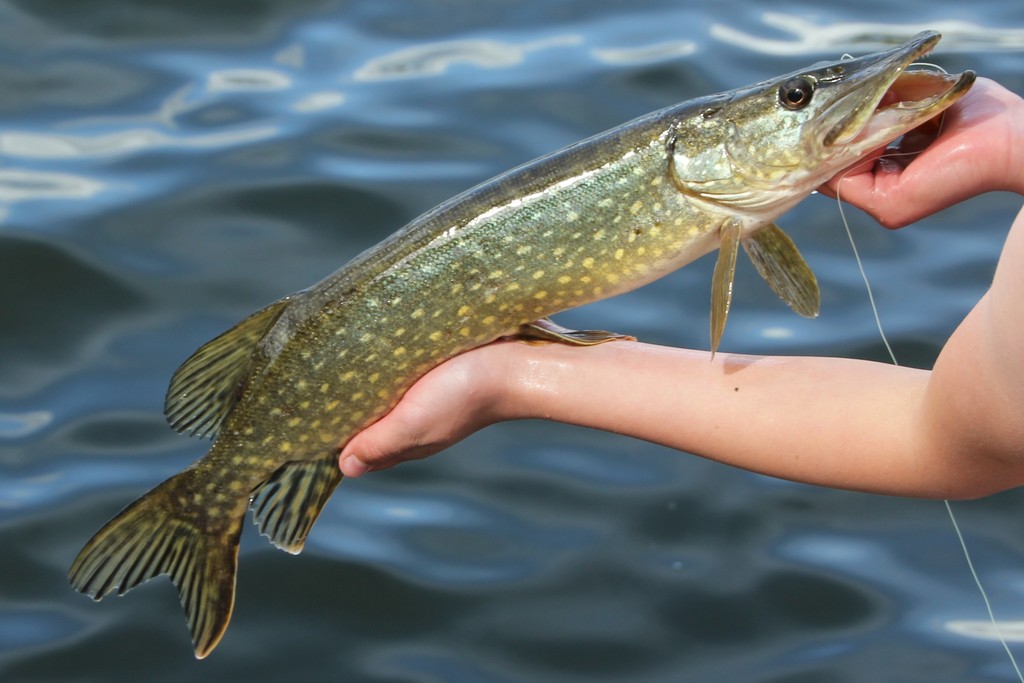
Northern Pike can be found in freshwater rivers, lakes, and streams throughout Canada and the United States. They prefer shallower areas with a gentle current and tend to hang out around rocky areas adjacent to weed beds, which give them some security and cover while they’re hunting for food.
As a solitary predator, the Northern Pike is an ambush fish. Their go-to move is to lurk on a weed bed, almost entirely motionless, looking a lot like a log or branch, waiting patiently for an unsuspecting baitfish to swim by before they strike. Relying more on their excellent eyesight rather than their sense of smell, Pike will search out any movement in the water. However, they’ll still take dead bait if the opportunity arises.
Essential Gear for Pike Fishing
Although there are some monsters in Northern Pike, most of the Pike you’ll catch will be around 5-10 lbs. So if you have a solid Bass setup, you shouldn’t need to go out and buy a new rod or reel just for Pike fishing. In the following section, we’ll cover some of the gear you’ll need to successfully catch your first Northern.
- Rod and Reel – A good 7-foot, medium-action rod, and reel combo, either with a bait caster or spinning reel, will be perfect for most of the Pike action you find yourself in. If you’re planning on targeting bigger fish, trolling, for example, then most experienced anglers recommend stepping it up a notch. Try switching to a medium-heavy action rod and reel combo if you’re targeting fish in the 15-30 lb. range.
- Fishing Line – Northern Pike have very sharp teeth, which will give them an opportunity to cut your line, so you need to consider that when you’re rigging up. If your reel is 15 lb. drag range, go for 15-20 lb. line. If you’re fishing with a heavier reel, try switching it up to a braided 30-40 lb. line. Don’t forget to add a heavier leader to your line, either a 40-50 lb. fluorocarbon or a wire bite. However, a wire bite will affect the lure’s action through the water.
- Landing Net – After battling a large Pike and getting it to the shore or edge of the boat, the last thing you want is to lose it lifting it in by the line. Those sharp teeth may not cut the line completely, but they can damage it, and lifting your fish by the line could be the final straw. A fish-safe landing net is an effective and safe way to not only land a fish but ultimately keep it as healthy as possible if you plan on returning it.
- Fishing Pliers – A dedicated pair of fishing pliers is a must for removing a hook from a Pike’s mouth. Northern Pike not only have razor-sharp teeth, but they also have sharp serrated gills which makes handling them very dangerous.
Read also: Fighting a Fish Even When You’re Outmatched
Best Baits for Northern Pike
One good thing about Northern Pike is that they’ll strike or eat almost anything they come across, including live baits, dead baits, and artificial lures. It gives you a lot of options when it comes to how you target these monster fish.
In this section, we’ll talk about some of the different bait and lure options you have when you’re fishing for a big Pike.
- Live Baits – The size of the bait will significantly impact the size of the fish you attract to your line. You can go with a variety of different live baits, including worms, minnows, baitfish, and leeches. The more movement it has and the more attractive it looks, the better your chances of attracting a Pike are.
- Crank Baits – If you’re fishing deeper water, then a deep diver like a crankbait is a great option, and in shallow water, you may want to switch it up to a jointed floater. Because of their multiple treble hooks, the chances of hooking up on a strike are high with crankbaits.
- Spoons & Spinners – Big spoons are very effective on Pike thanks to the amount of disturbance they create in the water. They also create a visual attractant and can be improved with colored threads or feathers. Spinners are typically a little smaller than most spoons and can be very effective on smaller fish.
- Soft Plastics & Jigs – Soft plastics and jigs are fantastic for smaller fish but typically not the best when it comes to landing big fish.
Techniques for Catching Northern Pike
Because of their strong attack and the way they hunt, almost all the Northern Pike you catch are going to be through trolling or casting, but be ready for the strike! When you feel the strike of a big Pike on your lure or fly, you’ll know it. There’s no second-guessing a big Northern strike.
Your preferred lure of choice should always be spooners and spinners, but hard plastics and jigs can also be effective. However, you’ll often find smaller fish targeting the soft plastics and jigs.
Spoons have a lot going for them because they create a lot of motion as they move through the water and also have a strong visual attraction thanks to the shiny side of the spoon. This flash as they cut through the water closely resembles the flash of a bait fish as it catches the sun’s reflection.
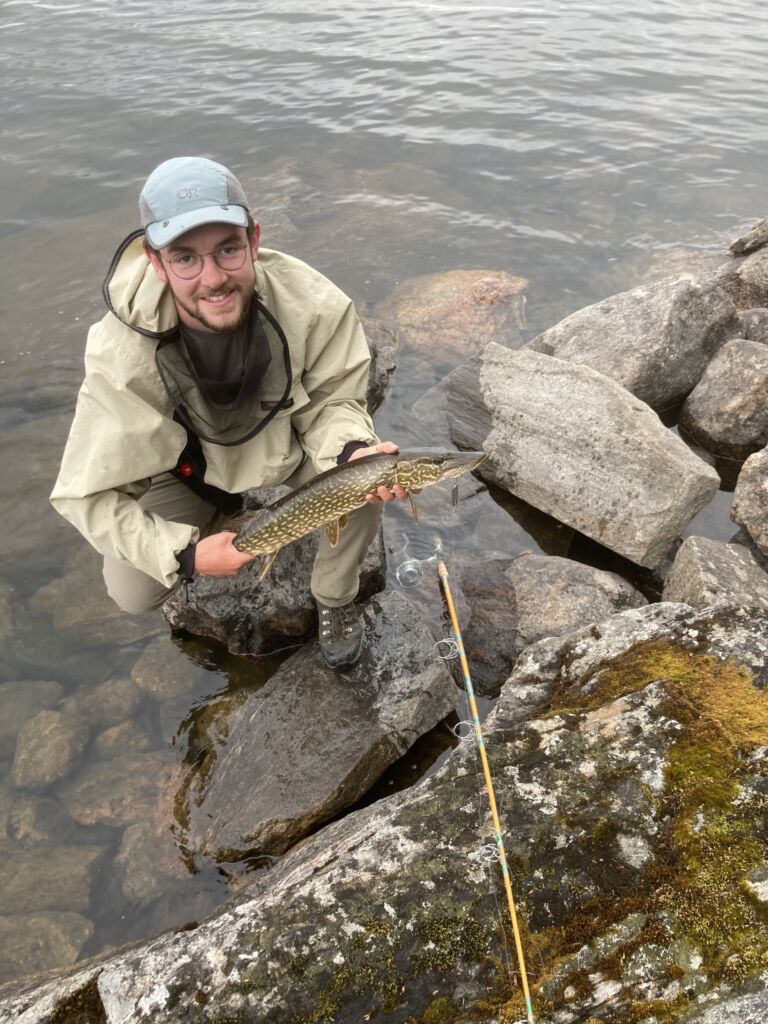
The weight of spoons is also an advantage for a variety of reasons. Firstly, you get a lot of casting distance, which is great when you’re shore fishing. Secondly, the weight also allows the spoon to sink, and by adjusting your retrieval speed, which is slow for deep water and faster for shallow water, you effectively fish a variety of depths with the same lure.
Hard plastic baits or jointed floaters are good in shallower waters as they allow you the opportunity to fish shallow water around structures, weed beds, and rocks without getting snagged into the bottom as much.
Medium-sized lures will always be a good choice for Northern Pike, but that doesn’t mean you should be scared to mix it up with some larger-sized lures. It’s not uncommon for a Pike to hit lures and baits which are up to 1/3rd of their size. If you’re chasing Pike in the 10 lbs. and up the range, an 8 to 10-inch lure isn’t a bad idea.
You should always keep your retrieval speed on the higher end of the scale as Pike love to strike, and their predatory nature will kick in if they see a tasty morsel passing them in the water. Try to retrieve over the top of weed beds and rocks, luring the Pike out of their ambush positions.
Best Locations for Pike Fishing
When you first arrive at your Northern Pike fishing destination, don’t go rushing straight in. Like all fishing, especially if you’re fishing in a new location or on a destination Pike fishing trip, take some time to carefully scout the area. It will not only save you a lot of time later, but it can also greatly increase your chances of catching a fish as you’ll be able to focus on the best areas first.
If you have access to depth charts and maps, that will help you a lot. Inlets, drop-offs, and bays are great places to start. You want to look for marshy shallow areas with weed beds and close access to structures such as logs, trees, dams, and other artificial structures. All these locations hold a lot of baitfish and minnows, and where the food is, the Pike won’t be far away just waiting for the perfect opportunity to strike.
The Top 5 Northern Pike Destinations in North America
You’ll find Northern Pike in various lakes and rivers throughout the United States and Canada, but there are some famous Pike fishing bodies of water. If you’re chasing a potential trophy, Northern, then these five destinations below will give you the best opportunity!
- Saskatchewan, Canada – Some of the best Pike fishing in North America can be found in Saskatchewan, and Wollaston Lake, Reindeer, Athabasca, and Misawa are all prime spots to catch a 30 lb. monster.
- The Northwest Territories, Canada – This destination is going to require a little bit of planning, but the Northwest Territories hold some of the biggest Northern Pike in North America, with 50-inch fish, which is definitely a realistic expectation.
- Ontario, Canada – While the Northwest Territories are quite a hike, fishing for Pike in Ontario will require a lot less logistical planning. There are various excellent Pike fishing opportunities throughout the province, including Eagle Lake, Red Lake, and probably the best of all, Lac Seul.
- Minnesota, USA – Minnesota proudly boasts some of the best Northern Pike fishing in the United States. Rainy Lake, located close to the border with Ontario, is possibly one of the best Pike destinations in the USA. Other popular Pike destinations include Lake Vermilion, Lake of the Woods, and any of the lakes in the Boundary Waters Canoe Area.
- Alaska, USA – Prepare for an adventure if you’re heading to Alaska chasing a big Pike. The locations can be challenging to access, but once you’re there, you’ll never want to leave!
Read also: Your Comprehensive Guide to Ontario Fishing Seasons
Pike Fishing Tips and Tricks
Below are our quick tips and tricks for catching Northern Pike:
- Understand the Location – Take your time to understand the area before you start fishing. If the fish aren’t biting in one area after a little bit of time, switch to a new area.
- Color and Vibration – Pike are visual hunters, so use lures that rattle, shake, and look flashy in the water in order to provoke them to strike.
- Bring the Right Gear – Northern Pike can grow up and be over 30 lbs. So if you’re chasing big fish, ensure that your rod, reel, line, and tackle can handle the sharp teeth of these aggressive fish.
- Use A Heavy Leader – Pike have sharp teeth and gills, so a leader is essential if you want to avoid being cut off.
- Bigger Is Better – Pike has good eyesight and isn’t afraid to take lures and baits up to a 3rd their size, so don’t be afraid of upsizing your equipment.
- Pliers Are Key – Don’t lift a Pike by the lips or gills. A specialty pair of fish pliers or needle nose pliers will save you a lot of bloodshed.
How to Catch Northern Pike – A Comprehensive Guide | Conclusion
By understanding Northern Pike, including the essential gear you need, the best baits, techniques, and locations to catch Northern Pike, you’ll have a much better chance of catching your dream fish. While there’s no guarantee when it comes to fishing, and we wouldn’t want it any other way, the better you understand your target species, the higher your chances will be.
As responsible anglers, it’s essential that we all do our part to preserve the fantastic fishing opportunities we all enjoy today. By following bag limits, season limits, size limits, and local fish and wildlife regulations such as purchasing permits or licenses, we’re all doing our part to preserve the resource for future generations of anglers to enjoy as much as we do.
Regardless of where you’re planning on going fishing for Northern Pike, the premium fish forecasting application Fishbox will put you in the perfect position to potentially land some fantastic fish by analyzing weather and water conditions along with input from local anglers. The Fishbox App utilizes accurate weather, tide, and fishing conditions to predict the best time to get out on the water to catch your target species.
Get your personalized fishing map
Answer a quick quiz and get your own personalized fishing map
Have you got a favorite bait, rig, or technique that you love to use when you go Northern Pike fishing that we didn’t cover above? Drop a comment below! We’d love to hear your feedback, and your tips and tricks could be just what a fellow angler needs to turn their luck around and catch their first Northern Pike.
